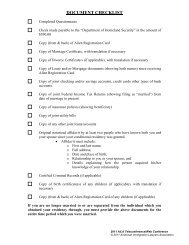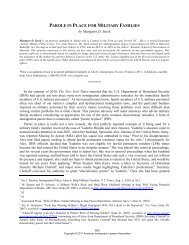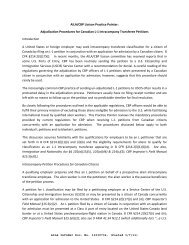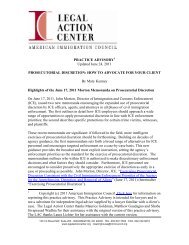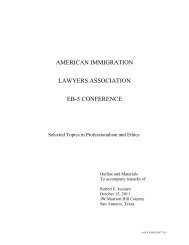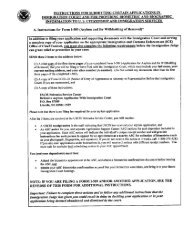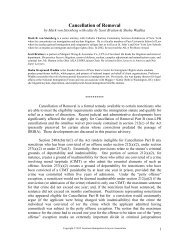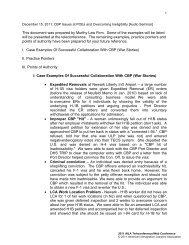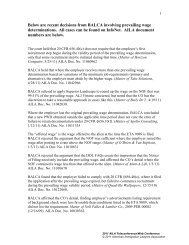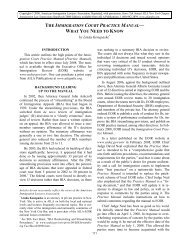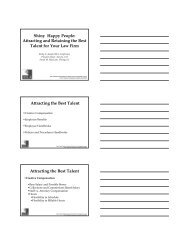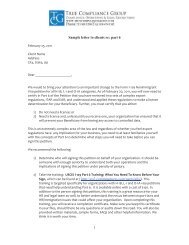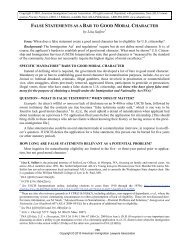Ch 5-Motions before the Immigration Court - AILA webCLE
Ch 5-Motions before the Immigration Court - AILA webCLE
Ch 5-Motions before the Immigration Court - AILA webCLE
Create successful ePaper yourself
Turn your PDF publications into a flip-book with our unique Google optimized e-Paper software.
None of <strong>the</strong>se documents specifically addresses <strong>the</strong> issues that arise when children’s asylum<br />
claims are presented in an adversarial setting. Therefore, in developing guidelines for <strong>the</strong> kinds of<br />
cases that we handle, <strong>the</strong> Office of <strong>the</strong> <strong>Ch</strong>ief <strong>Immigration</strong> Judge (OCIJ) sought additional guidance<br />
primarily from materials developed for juvenile and family courts. The guidelines that follow are<br />
based upon <strong>the</strong> asylum-specific documents mentioned above and <strong>the</strong> writings of judges and litigators<br />
in o<strong>the</strong>r areas of <strong>the</strong> law.<br />
II. Definition of unaccompanied alien child<br />
The definition of <strong>the</strong> term “child” may differ depending on <strong>the</strong> context in which it is used.<br />
These guidelines use <strong>the</strong> terms “child” and “children” in a way that is slightly different from <strong>the</strong><br />
definitions provided in <strong>the</strong> <strong>Immigration</strong> and Nationality Act (INA or Act). The Act defines a “child”<br />
as an unmarried person under 21 years of age. Sections 101(b)(1) and 101(c)(1). The regulations<br />
follow this statutory definition. The regulations also define a “juvenile” as an alien under <strong>the</strong> age<br />
of 18. 8 C.F.R. § 1236.3. The regulations also use (but do not define) <strong>the</strong> word “minor” when<br />
describing aliens under 14 years of age. 8 C.F.R. § 1236.2.<br />
The Homeland Security Act of 2002 transferred responsibility for detained alien children<br />
from <strong>the</strong> former INS to <strong>the</strong> Department of Health and Human Services (HHS) and <strong>the</strong> Department<br />
of Homeland Security (DHS). It also introduced a new term -- unaccompanied alien child -- to<br />
define a child who has no lawful immigration status in <strong>the</strong> United States, has not attained 18 years<br />
of age, and who has no parent or legal guardian in <strong>the</strong> United States, or no parent or legal guardian<br />
in <strong>the</strong> United States available to provide care and physical custody. The Office of Refugee<br />
Resettlement (ORR) within HHS is responsible for unaccompanied alien children, while DHS is<br />
responsible for accompanied children.<br />
These guidelines use <strong>the</strong> term “unaccompanied alien child” as defined in <strong>the</strong> Homeland<br />
Security Act of 2002 -- that is, a person under 18, without a parent or legal guardian in <strong>the</strong> United<br />
States or without a parent or legal guardian in <strong>the</strong> United States who is available to provide care and<br />
physical custody. Once a person attains <strong>the</strong> age of 18, or has a parent or legal guardian in <strong>the</strong> United<br />
States who is available to provide care and physical custody, he or she would not fall within <strong>the</strong><br />
definition. All references to “child” or “children” in <strong>the</strong>se guidelines should be construed to mean<br />
an “unaccompanied alien child” as defined in <strong>the</strong> Homeland Security Act of 2002.<br />
III. Basic principles<br />
Several principles are central to <strong>the</strong>se guidelines:<br />
A. Authority. Every immigration judge is expected to employ child sensitive<br />
procedures whenever a child respondent or witness is present in <strong>the</strong> courtroom.<br />
However, it is equally true that all such cases are not alike, and <strong>the</strong> procedures<br />
appropriate for a very young child may differ significantly from those appropriate for<br />
a teenager. These guidelines are suggestions that should be applied as circumstances<br />
warrant. All immigration judges understand that special attention is required for<br />
3



